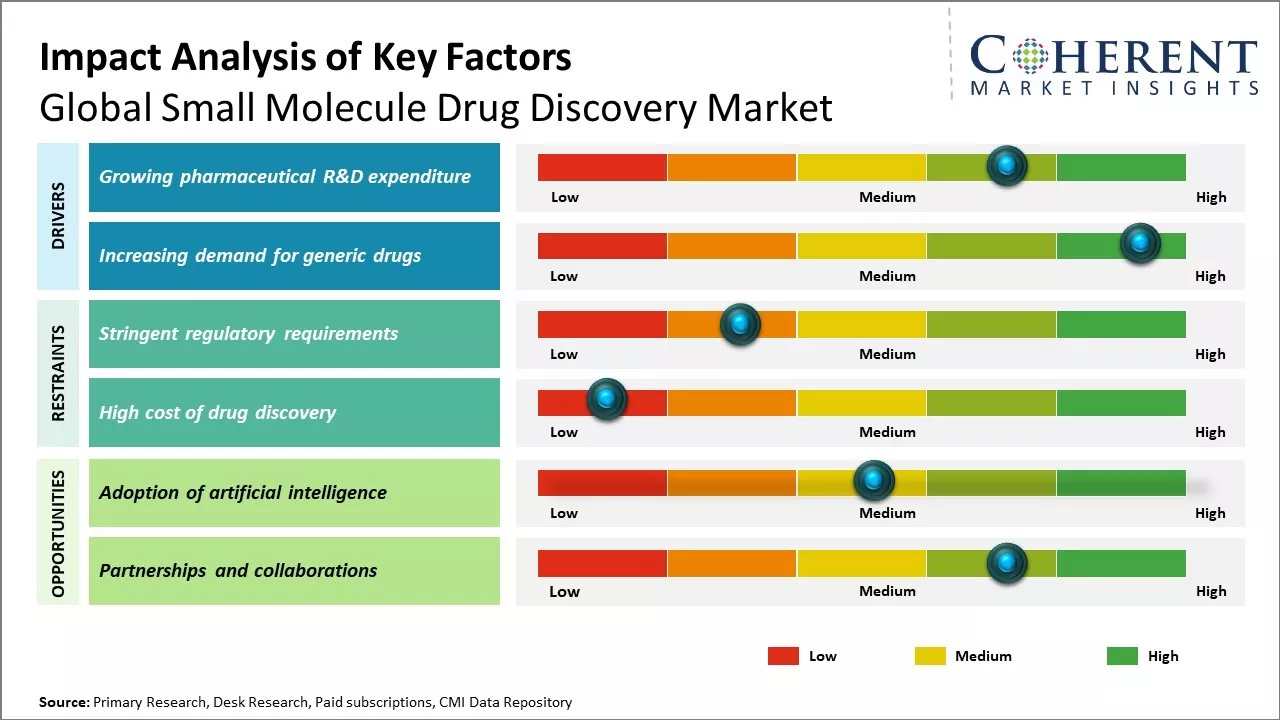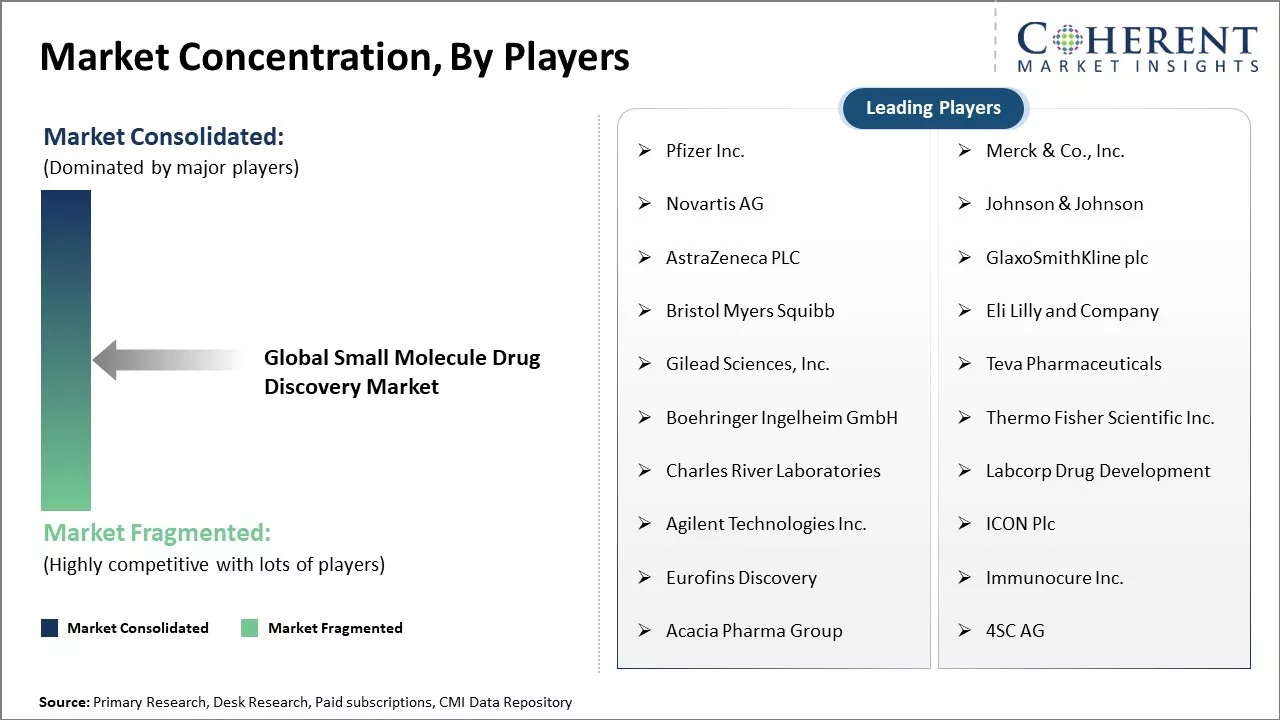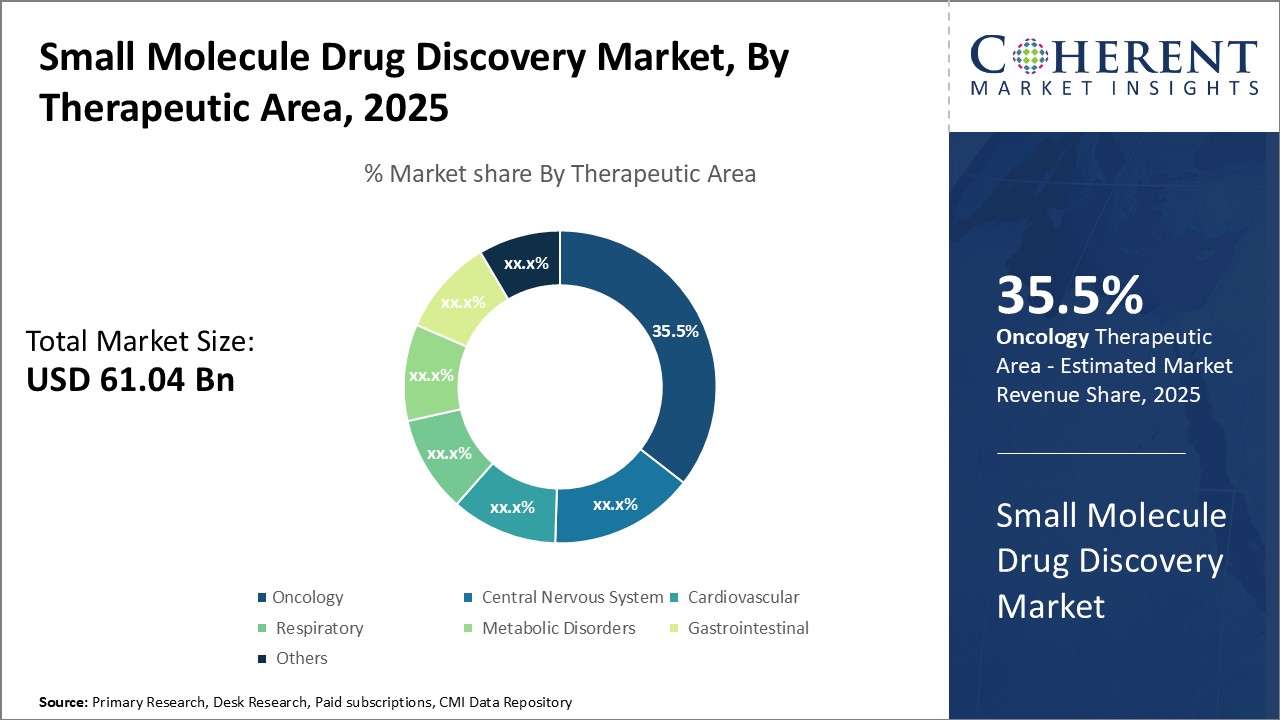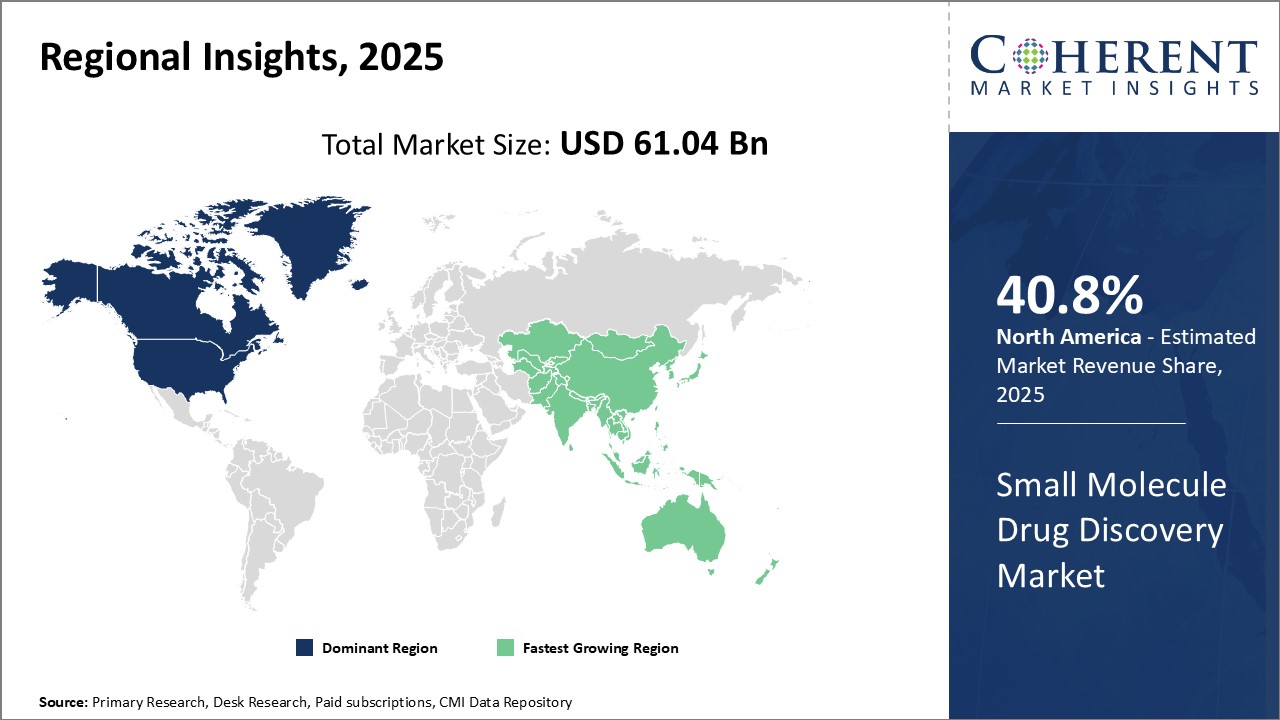Global small molecule drug discovery market is estimated to be valued at USD 61.04 Bn in 2025 and is expected to reach USD 110.23 Bn by 2032, exhibiting a compound annual growth rate (CAGR) of 8.8% from 2025 to 2032.

Discover market dynamics shaping the industry: Download Free Sample
Global small molecule drug discovery market growth is driven by increasing investment in research and development by pharmaceutical companies to develop small molecule drugs for treating various therapeutic applications. Growing prevalence of chronic diseases such as cancer and rising demand for small molecule drugs with better efficacy can drive the market growth. Development of advanced technologies to expedite the small molecule drug discovery process can offer lucrative opportunities in the near future. However, high costs associated with drug development and strict regulatory framework can hamper the market growth over the forecast period.
Market Driver - Growing pharmaceutical R&D expenditure
Global pharmaceutical industry has witnessed rising research and development expenditure over the past few years. Major pharmaceutical companies are investing heavily in drug discovery and development, in order to build robust pipelines of new molecular entities. There has been intense competition among leading pharma players to be the first to launch new drugs in high potential therapy areas. This boosts huge capital investment for setting up state-of-the-art R&D facilities, conducting clinical trials, and acquiring promising drug candidates from smaller biotech companies through mergers and acquisitions. Small molecule drugs still account for the majority of new drug approvals by regulatory agencies despite the rising popularity of biologics. Developing a new small molecule drug requires extensive experimentation, screening of chemical compounds, and optimization processes that are highly capital-intensive in nature. The continual need to replace blockbuster drugs that are going off-patent coupled with rising costs of drug development have forced pharma companies to focus on areas with higher commercial potential. This is evidenced by the growing dominance of specialty drug segments like oncology, neurology, and immunology in terms of R&D spending and pipeline candidates of major players. Developing drugs for complex therapeutic areas also necessitates newer paradigms like target identification, assay development, screening, molecular modeling, and analytics which are enabled by advancements in technologies. Small molecule approaches also play an important role in these segments due to advantages over biologics in terms of cost of goods, stability, and delivery mechanisms.

Get actionable strategies to beat competition: Download Free Sample
Increasing demand for generic drugs
The huge patient population suffering from chronic lifestyle disorders worldwide has put immense economic burden on healthcare systems of various countries. This factor, along with patent expiry of several blockbuster drugs, boosts demand for affordable generic versions. According to estimates, generics account for over 80% of total prescriptions filled in the U.S. currently. Major pharmaceutical markets like the U.S., key European nations, India, China are taking initiatives to promote generic drugs penetration through policies and investments. India has emerged as the global ‘pharmacy,’ owing to its large generics manufacturing capabilities and low cost of production. Meanwhile, companies in developed markets are also expanding generics portfolios and building affordable manufacturing capacities. The generic drug development process relies significantly on bioequivalence studies involving small molecule drugs to demonstrate therapeutic equivalence to reference listed drugs. Generic drugs offer up to 80% lower costs as compared to their branded counterparts. However, developing generic versions also pose technical challenges related to complex drug delivery mechanisms, multi-component formulations, and lack of readily available process information. This necessitates investments in enhancing reverse engineering capabilities, analytical techniques, and manufacturing infrastructure. Rising healthcare access and awareness about cost benefits of generics in emerging pharma hubs can stoke demand. Affordable small molecule generics also play a key role in easing treatment costs for a variety of chronic conditions globally.
Key Takeaways from Analyst:
Global small molecule drug discovery market growth is driven by rising pharmaceutical R&D spending and increasing demand for highly targeted therapies. North America currently dominates the market owing to presence of prominent pharmaceutical players and growing research activities in the region. However, Asia Pacific region is expected to be the fastest growing region due to increasing government focus on generics production in countries like India and China.
High costs associated with small molecule drug development and increasing complexity of targets that require specialized technique and technologies for designing small molecule drugs can hamper the market growth. Growing outsourcing of early-stage small molecule research to CROs can offer lucrative opportunity for various stakeholders in the value chain. Advancements in fields such as artificial intelligence, automation, and high-throughput screening can boost efficiency and lower costs involved in the discovery process Adoption of multi-disciplinary approach combining medicinal chemistry, molecular modeling and computational techniques has improved hit rates, thus, driving market expansion. Collaborations between large pharma players and smaller biotechs enable leveraging of core competencies and complementary capabilities, thus, opening new avenues for smaller bio companies and startups in the field of precision medicine.
Market Challenge - Stringent regulatory requirements
Global small molecule drug discovery market growth can be hampered due to stringent regulatory requirements imposed by regulatory authorities around the world. Compliance with regulations has become a complex and costly affair for pharmaceutical companies. Obtaining regulatory approval for new drug candidates involves rigorous clinical testing on humans which is a long, expensive and risky process. Any changes to manufacturing processes or facilities are also closely scrutinized. Non-compliance can delay drug launches and incur huge financial penalties. The approval timelines have also become longer. Meeting all regulatory norms prescribed by different countries can hamper the market growth. Such stringent regulatory environment has increased the research and development costs and time for drug developers.
Market Opportunity: Adoption of artificial intelligence
Rising adoption of artificial intelligence can offer growth opportunities for global small molecule drug discovery market players. AI and machine learning algorithms can help analyze huge datasets to identify new drug targets and molecules at a fraction of the traditional cost and time. Companies are increasingly utilizing AI throughout the drug discovery workflow from target identification and validation to lead optimization. It helps expedite the discovery process and reduces risks of failure in later stages. The ability of AI to sift through massive chemical libraries and clinical trials data is empowering researchers. AI may help address the industry’s pressing need to boost productivity and bring more drugs to the market overcoming stringent regulations. Its potential to streamline operations and enhance efficiency provides significant growth avenue for stakeholders.

Discover high revenue pocket segments and roadmap to it: Download Free Sample
By Therapeutic Area- Growing Burden of Cancer Drives Oncology Segment Growth
In terms of therapeutic area, oncology segment is estimated to contribute the highest market share of 35.5% in 2025, owing to growing burden of cancer globally. Cancer is one of the leading causes of mortality worldwide, with an estimated 10 million deaths in 2020. Rising incidences of various cancers such as lung cancer, breast cancer, prostate cancer and colorectal cancer leads to increased focus on small molecule drug discovery in oncology. Small molecule drugs provide targeted and specific solutions to treat complex cancers at the cellular and genetic level. Continued research and clinical trials for new small molecule drugs provide promising results in treating both solid tumors as well as hematological cancers more effectively. Areas such as molecularly targeted therapy, immunotherapy and epigenetic modifications attract significant R&D investments from pharmaceutical companies for developing novel oncology therapeutics. The availability of advanced technologies in genomic profiling and biomarker analysis can aid drug discovery in oncology. Rising demand for personalized medicines along with high unmet needs can offer market opportunity for small molecule drug discovery players.
By Process - Expanding Target and Biomarker Identification Drives Target Validation
In terms of process, target ID/validation segment is estimated to contribute the highest market share of 42.8% in 2025, due to continuous focus on widening disease understanding. Early identification of suitable molecular targets and downstream biomarkers is critical for successful small molecule drug discovery and development programs. Target validation involves assessing the safety, drug ability and involvement of potential targets in human biology and disease pathways. Advancements in genomic technologies along with multi-omics approaches help researchers to gain deeper insights into disease mechanisms at the systemic level. This widen the number of drug targets being explored and validated through high-throughput screening and other methods. 3D biological modelling, artificial intelligence, and big data analytics further augment target identification capabilities. Investments in target discovery collaborations between industry and academia have increased in recent years. Pharmaceutical companies are placing increased priority on target validation in their portfolios to optimize downstream drug discovery investments. Continuous expansion of validated targets can facilitate the evaluation of a wider range of first-in-class small molecules over the long term.

Need a Different Region or Segment? Download Free Sample
North America is estimated to dominate the global small molecule drug discovery market with an estimated market share of 40.8% in 2024The region is home to major pharmaceutical companies with strong in-house research and development capabilities. These companies are engaged in developing innovative small molecule drugs and continue to invest heavily in R&D activities. The presence of top CROs and CMOs supports drug development programs by providing specialized services.
The region also has favorable regulatory environment and government funding for research. For instance, 21st Century Cures Act aims to accelerate medical product development. This encourages clinical trials and speeds up the approval process. Furthermore, industry-academia collaborations are widespread, facilitating exchange of knowledge and resources. Leading research universities contribute to progress through fundamental scientific findings. With its established pharmaceutical industry and supportive ecosystem, North America provides a conducive environment for small molecule drug R&D.
Asia Pacific has emerged as the fastest growing regional market. Countries like China, India, Japan and South Korea are increasingly participating in global drug development activities. These offer significant cost benefits compared to developed markets. As a result, pharmaceutical companies are increasingly outsourcing early stage research and clinical trials to the region. The capability and quality of local CROs and CMOs has improved substantially.
Small Molecule Drug Discovery Market Report Coverage
| Report Coverage | Details | ||
|---|---|---|---|
| Base Year: | 2024 | Market Size in 2025: | USD 61.04 Bn |
| Historical Data for: | 2020 To 2024 | Forecast Period: | 2025 To 2032 |
| Forecast Period 2025 to 2032 CAGR: | 8.8% | 2032 Value Projection: | USD 110.23 Bn |
| Geographies covered: |
|
||
| Segments covered: |
|
||
| Companies covered: |
Pfizer Inc., Merck & Co., Inc., Novartis AG, Johnson & Johnson, AstraZeneca PLC, GlaxoSmithKline plc, Bristol Myers Squibb, Eli Lilly and Company, Gilead Sciences, Inc., Teva Pharmaceuticals, Boehringer Ingelheim GmbH, Thermo Fisher Scientific Inc., Charles River Laboratories, Labcorp Drug Development, Agilent Technologies Inc., ICON Plc, Eurofins Discovery, Immunocure Inc., Acacia Pharma Group, 4SC AG |
||
| Growth Drivers: |
|
||
| Restraints & Challenges: |
|
||
Uncover macros and micros vetted on 75+ parameters: Get instant access to report
*Definition: Global Small Molecule Drug Discovery Market involves research and development of new small molecule drug candidates by pharmaceutical and biotechnology companies. Small molecule drugs have a low molecular weight and can enter cells easily to perform their intended function. This market focuses on R&D of small molecule drugs for various therapeutic applications including oncology, cardiology, neurological disorders and others.
Share
Share
About Author
Vipul Patil is a dynamic management consultant with 6 years of dedicated experience in the pharmaceutical industry. Known for his analytical acumen and strategic insight, Vipul has successfully partnered with pharmaceutical companies to enhance operational efficiency, cross broader expansion, and navigate the complexities of distribution in markets with high revenue potential.
Missing comfort of reading report in your local language? Find your preferred language :
Transform your Strategy with Exclusive Trending Reports :
Frequently Asked Questions
Joining thousands of companies around the world committed to making the Excellent Business Solutions.
View All Our Clients